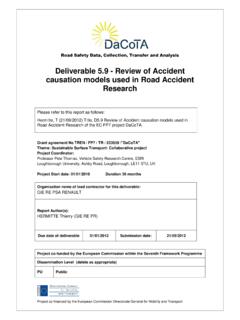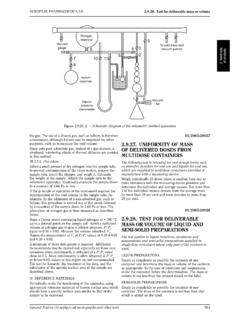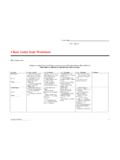Transcription of Deliverable 1.5 Vol.1 Analysis of the stakeholder …
1 Project co-financed by the European Commission Directorate General for Mobility and Transport Road Safety Data, Collection, Transfer and Analysis Deliverable Analysis of the stakeholder survey: perceived priority and availability of data and tools and relation to the stakeholders' characteristics. Please refer to this report as follows: Papadimitriou, E, Yannis, G. Gitelman V., Doveh, E., and Dupont, E., (Eds.) Analysis of the stakeholder survey: perceived priority and availability of data and tools and relation to the stakeholders' characteristics. Deliverable (Vol. 1) of the EC FP7 project DaCoTA. Grant agreement No TREN / FP7 / TR / 233659 /"DaCoTA" Theme: Sustainable Surface Transport: Collaborative project Project Coordinator: Professor Pete Thomas, Transport Safety Research Centre, Loughborough Design School, Loughborough University, Ashby Road, Loughborough, LE11 3TU, UK Project Start date: 01/01/2010 Duration 30 months Organisation name of lead contractor for this Deliverable : NTUA - National Technical University of Athens Report Author(s): Eleonora Papadimitriou and George Yannis, NTUA Victoria Gitelman and Etti Doveh, Technion Rachel Talbot, TSRC Klaus Machata, KfV Emmanuelle Dupont, IBSR Due date of Deliverable 31/12/2012 Submission date: 31/12/2012 Project co-funded by the European Commission within the Seventh Framework Programme Dissemination Level (delete as appropriate) PU Public TABLE OF CONTENTS Executive summary.
2 4 1. Introduction .. 7 2. Data Treatment .. 11 Missing values .. 11 Coding of 11 Background variables .. 11 Priority and availability ratings .. 13 3. Dimensions underlying the availability and priority ratings .. 15 Method .. 15 Results .. 16 Principal Component Analysis (PCA) on priority ratings .. 16 Principal Component Analysis on availability ratings .. 19 Factor Analysis on the combined needs scale .. 22 Conclusions .. 26 4. Clustering: Grouping the stakeholders on the basis of the Dimensions identified .. 29 Objectives .. 29 Method .. 30 Results .. 31 Grouping stakeholders on the basis of the priority component scores .. 31 Grouping stakeholders on the basis of availability component scores .. 36 Conclusions from the separate analyses .. 39 Grouping stakeholders on the basis of the combined needs factors .. 40 Conclusions from the combined needs Analysis .. 47 5. Discussion and recommendations.
3 49 6. References .. 52 Appendix 1: characteristics of no-responses and incomplete questionnaires 53 Appendix 2: Cross-tabulation of priority and availability scores .. 56 Appendix 3 Selection of components and factors .. 57 Appendix 4 Selection of Clusters: .. 66 Appendix 5: Within-Country comparisons .. 72 1. Austria (AT) .. 72 2. Poland (PL) .. 74 3. Spain (ES) .. 75 4. United Kingdom (UK) .. 77 Deliverable Detailed Analysis of the stakeholder survey DaCoTA_Deliverable1 5_Vol1_final 4 EXECUTIVE SUMMARY This report is part of the Policy Work Package of the DaCoTA project ( ). The Policy Work Package is designed to fill in the gap in knowledge on road safety policy making processes, their institutional framework and the data, methods and technical tools needed to base policy formulation and adoption on scientifically-established evidence. This document provides the results of a detailed Analysis of a survey conducted with a large panel of stakeholders.
4 The aim was to assess what they considered to be priorities and necessities in terms of scientific data, information, and tools to conduct their road safety activities. The aim is to improve our knowledge of the items that should be included in the ERSO website or that are included in the website already but deserve being highlighted somewhat. Concrete recommendations are eventually made that should contribute to the ERSO s usefulness for a wide variety of road safety actors. The present report builds on a model that has been previously defined in the same Work Package to formally describe the Road Safety Management process, and to couple it with scientific input. This model conceives road safety management as involving 4 key tasks: (1) Fact Finding; (2) Programme Development; (3) Preparing Implementation; (4) Monitoring and evaluation. For each type of task, scientific support may prove necessary, either in terms of data, tools for the treatment of these data, training tools, or other decision-support tools (see Muhlrad, Gitelman, & Buttler, 2011 for a detailed description of the road safety management model used).
5 The Road Safety Management model has first served as basis for the interview of a panel of road safety experts (see Muhlrad &, Dupont, 2010 for a complete report of the interview Analysis ). Their answers served as basis to design a questionnaire which was meant to be submitted to a wider array of stakeholders involved in road-safety. This questionnaire contained questions concerning the background of the stakeholders and, structured around the 4 road safety management tasks listed above, a list of possible data, information, and tools that could be used as input for the different tasks. The stakeholders answering the questionnaire were asked to rate each of these items level of priority for the type of road safety activities that they were performing along with its availability. In total, 512 stakeholders returned the questionnaire. A first description of the results can be found in Machata, Barnes, & Jahi, 2011.
6 The present Deliverable contains the results of a further in-depth Analysis of the stakeholders answers to that survey. In a first step, common dimensions underlying the priority and availability ratings of the tools listed in the questionnaire have been identified. Then, in a second step, these dimensions were used to identify groups (clusters) among the stakeholders. Finally, it was investigated whether the groups formed on the basis of the underlying priority-availability dimensions were associated with variation in the background characteristics of the stakeholders (country, type of organisation they were working for, type of road safety activities in which they were involved). Each of these Analysis steps was performed in 2 different ways: Firstly, treating the priority and availability ratings separately, and secondly, by recoding the priority and availability ratings so as to recombine them into a common scale (the higher the score on this new scale, the more the item is considered to be a priority and to be unavailable).
7 For this reason, the second type of data treatment is referred to as the needs Analysis . The results revealed that meaningful dimensions can be identified that summarize the priority-availability ratings of the items included in the questionnaire in an efficient Deliverable Detailed Analysis of the stakeholder survey DaCoTA_Deliverable1 5_Vol1_final 5 way. This was the case both when the priority and availability ratings were treated separately or recombined into a needs scale. Although the content of the dimensions identified varies somewhat depending on the type of data treatment, most of them display important similarities in content. Other dimensions, on the other hand, emerge more specifically when analysing the availability ratings or the combined needs scale. These dimensions furthermore ease the grouping of the stakeholders on the basis of their priority and availability ratings of the more than 50 items originally listed in the questionnaire.
8 Working exclusively on the priority ratings, 4 different clusters were identified: Cluster 1 representing the stakeholders with low priority for everything ; Cluster 2 representing the stakeholders considering that data and models are specifically important, Cluster 3 includes stakeholders that tend to assign high priority for everything, but especially implementation , Cluster 4 corresponds to stakeholders assigning high priority to in-depth data mostly The investigation of the relation between the different clusters the stakeholders are assigned to and their background characteristics reveals no clear relation with the type of country they originate from. They are however more clearly related to the type of organisation the stakeholders work for, stakeholders from the industry appear to be over-represented in the 4th cluster, while those from associations and interest groups tend to be over-represented in the third one and stakeholders working in national or regional administrations tend to be over-represented in cluster 2.
9 On the basis of availability ratings, 3 clusters were identified: The first one groups stakeholders who basically declare that information on costs and benefits of measures are available, but that models are not. Cluster 2 corresponds to stakeholders declaring that models are available, but that data and definitions are needed. Finally, stakeholders in Cluster 3 request information about the costs and benefits of measures. Again, the investigation of background characteristics reveals little association with the countries the stakeholders work in, but a stronger relationship with the type of organisation they work for. Stakeholders from both research institutes and national/regional organisations tend to be over represented in the first cluster, but under-represented in the third one, while stakeholders from associations and interest groups tend to be over-represented in the second cluster.
10 Finally, when working with the combined needs scale, 6 clusters are identified: Cluster 1 needs for most items, especially accident and infrastructure Analysis ; Cluster 2 moderate needs for all , Cluster 3 High needs for models, moderate needs in other, implementation unimportant , Cluster 4 No needs for models, moderate needs in implementation Cluster 5 Low importance of implementation and models, moderate needs in crash causation Cluster 6 High needs for implementation but no use of accident and infrastructure analyses Deliverable Detailed Analysis of the stakeholder survey DaCoTA_Deliverable1 5_Vol1_final 6 The stakeholders in the first cluster only rarely state that data and tools are of high importance for their professional activities, do not seem to use databases (national and international) much, and tend to declare more that they are very satisfied with the data and resources currently available.






